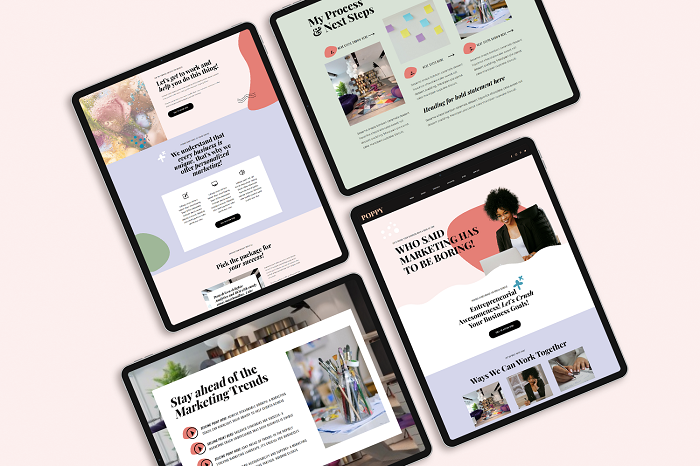9 Things to Consider When Shopping for a Website Template
If you’re in the market for a new website, but a custom design is not in your budget, you may be considering purchasing a template. (Which would be a great choice!) However, there are a few things to keep in mind, as not all templates are created equally. Let’s dive in.
Responsive Design & Mobile Friendly
Responsive Design: With a huge percentage of web viewers being mobile users these days, it’s important that your website template is mobile-friendly and adapts well to different screen sizes and devices – AKA Responsive. It’s essential to provide a seamless user experience across various devices. Although most web platforms are focused on responsiveness, don’t assume every template will be designed with that in mind. If the template you’re considering purchasing allows you to view the demo site, make sure you view it on your mobile as well as desktop. Also, keep in mind the ease of being able to make your customizations mobile-friendly as you make the edits to your templates.
Website Strategy
How well is your content going to fit into the provided sections and layout of the template? Truth be told, content should dictate design, not the other way around. Even if you don’t already have all of your copy written, you should have a general idea of what you need to include on your website. Then look for a template that has placeholders for that content. For instance, if you’re a photographer, you’re probably not going to want a template that doesn’t include a portfolio. Unless of course, you can see where you’d be able to take from other sections of the template to piece together a portfolio page. One of the beautiful things about Showit templates is that you’re able to move sections around, duplicate them, and use them in various places on your website.
Customizability
Look for a template that allows you to customize as much as possible! You might be thinking, “This template is gorgeous – I don’t want to change a thing!” “I Just want to swap my photos in and add my copy.” But in reality, if you’re designing a website to convert, you’re going to need to be able to make customization as needed. Even if they are just minor tweaks, for instance, your paragraph on the bio section of the homepage is one line longer than the paragraph in the template. When you add yours in, it messes up the spacing between that section and the following section and now it just doesn’t look right. What are you going to do? Delete the last line of your paragraph? I don’t think so! Adjust the spacing! It’s an easy fix on a platform like Showit. However, a lot of website platforms make it incredibly difficult to make minor spacing adjustments.
User-Friendly
This technically could go under “website strategy” but I felt it deserved it’s own. How easy is it for the viewer to navigate? How well is the menu laid out? How easy is it to find essential information? Does the website guide you through a seamless customer journey?
SEO-Friendly Features
Is the template setup for easy SEO customization? Are the heading tags used correctly? Header Checker is a free Chrome extension that allows you to check the H1-H6 tags of any web page, (even website template demos.) You’ll also want to make sure the platform the template is designed for includes built-in SEO features or is compatible with popular SEO plugins.
Integration Capabilities
Consider the compatibility of the template (and the platform the template is designed for) with third-party tools you might need, such as a scheduler, email marketing provider, social media integration, analytics, and e-commerce. Make sure the platform supports the functionalities you require for your business. It would be a doozy to purchase a template you love only to find out that it’s built specifically for a web platform that just isn’t going to work for your business!
Support & Updates
When it comes to support and website maintenance, you want a platform or template provider that has your back. Are they readily available to assist you, or are you left to navigate the world of website security and software updates on your own? Let me tell you, Showit shines bright in this area! Their customer support is phenomenal! They truly go above and beyond to ensure you have the guidance and assistance you need. And that’s not all – they have an extensive library filled with tutorials and training to make customizing your template and navigating their platform a breeze. Showit takes care of all the software updates for you, ensuring your website remains up-to-date and secure.
Pricing
Last but not least. Does the price-tag fit your budget? Templates are a great way to get the professionally designed look without the custom designer price-tag. You could easily pay between $2,000 to $5,000 (and even beyond) for a custom-designed website. Most website templates cost between $250 to $1200. Which, even at the high-end, you’re still getting a bargain. My templates start at $297! Check them out here!
The Design
This one might seem like a total no-brainer. Does the design match your brand style and values? Keep in mind, the colors and fonts can be customized. So even if you like the layout and design style of a particular template but not the colors, remember that it can take on a completely different look when it has your colors added to it. Here’s an example of 2 very different looks using the same template:
Conclusion
Well, there you have it! When shopping for a website template, there are many things to consider aside from the obvious, “Do I like this design?”
If you’re ready to get started with a website template, I highly recommend using a template designed for the Showit platform. You can check out my templates designed specifically for Showit!
